Construction Practice Management Report: UK Industry and Strategies
VerifiedAdded on 2022/09/16
|15
|4833
|25
Report
AI Summary
This report provides an in-depth analysis of construction practice management, focusing on the UK construction industry. It explores key aspects such as market trends, economic factors influencing demand, and the significance of ethical concerns. The report delves into the role of various construction companies, including general contractors and owner-builders, and examines different types of construction contracts like time and material, unit pricing, and cost-plus contracts. It highlights the importance of procurement policies, financial planning, and stakeholder management in ensuring project success. The report also discusses the significance of labor efficiency, system integration, and ethical considerations within the construction industry, emphasizing the need for long-term strategic planning and adherence to ethical standards. Furthermore, it examines the role of negotiation, contracts, and financial instruments in the construction process, underscoring the importance of clear agreements and effective management to achieve project goals.
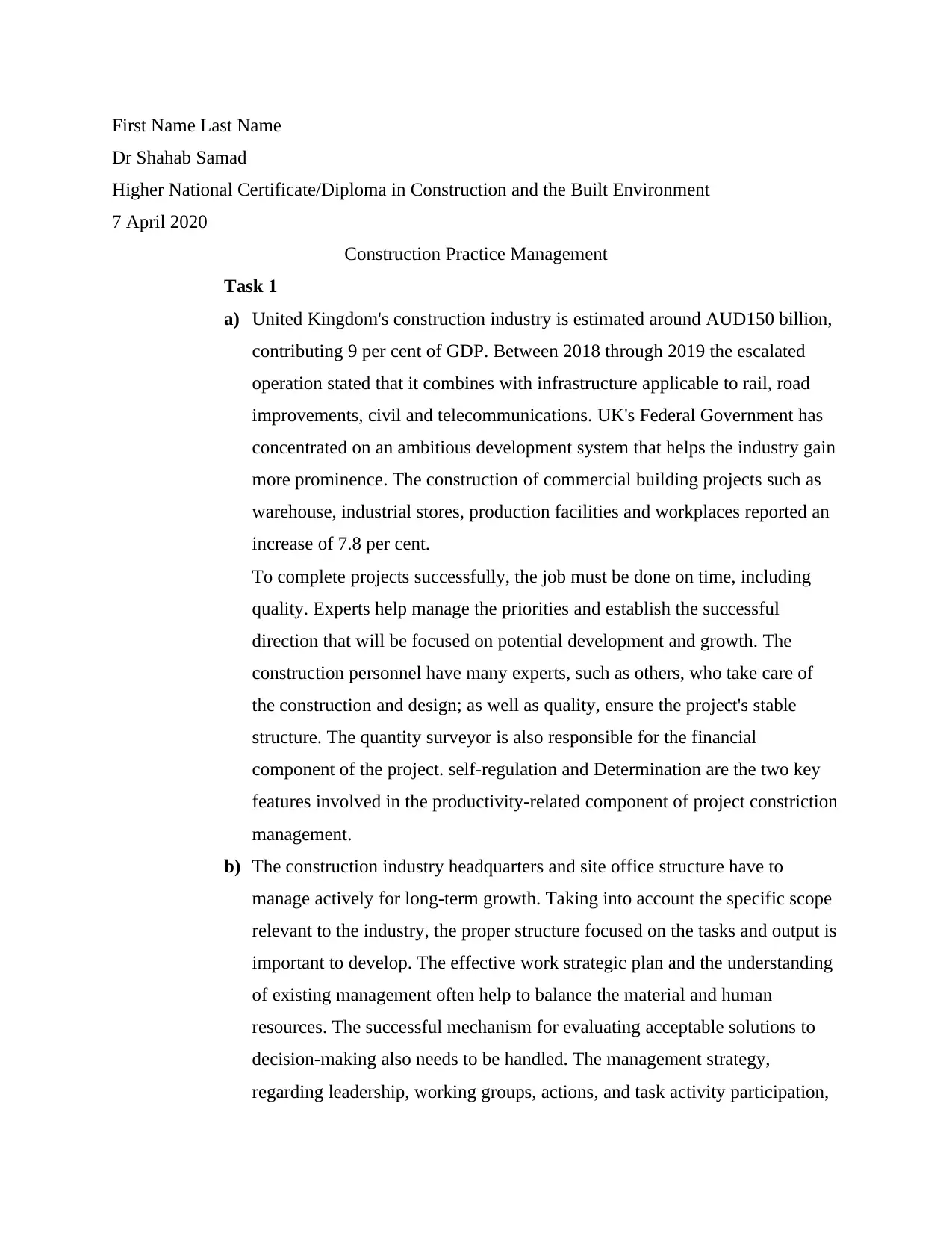
First Name Last Name
Dr Shahab Samad
Higher National Certificate/Diploma in Construction and the Built Environment
7 April 2020
Construction Practice Management
Task 1
a) United Kingdom's construction industry is estimated around AUD150 billion,
contributing 9 per cent of GDP. Between 2018 through 2019 the escalated
operation stated that it combines with infrastructure applicable to rail, road
improvements, civil and telecommunications. UK's Federal Government has
concentrated on an ambitious development system that helps the industry gain
more prominence. The construction of commercial building projects such as
warehouse, industrial stores, production facilities and workplaces reported an
increase of 7.8 per cent.
To complete projects successfully, the job must be done on time, including
quality. Experts help manage the priorities and establish the successful
direction that will be focused on potential development and growth. The
construction personnel have many experts, such as others, who take care of
the construction and design; as well as quality, ensure the project's stable
structure. The quantity surveyor is also responsible for the financial
component of the project. self-regulation and Determination are the two key
features involved in the productivity-related component of project constriction
management.
b) The construction industry headquarters and site office structure have to
manage actively for long-term growth. Taking into account the specific scope
relevant to the industry, the proper structure focused on the tasks and output is
important to develop. The effective work strategic plan and the understanding
of existing management often help to balance the material and human
resources. The successful mechanism for evaluating acceptable solutions to
decision-making also needs to be handled. The management strategy,
regarding leadership, working groups, actions, and task activity participation,
Dr Shahab Samad
Higher National Certificate/Diploma in Construction and the Built Environment
7 April 2020
Construction Practice Management
Task 1
a) United Kingdom's construction industry is estimated around AUD150 billion,
contributing 9 per cent of GDP. Between 2018 through 2019 the escalated
operation stated that it combines with infrastructure applicable to rail, road
improvements, civil and telecommunications. UK's Federal Government has
concentrated on an ambitious development system that helps the industry gain
more prominence. The construction of commercial building projects such as
warehouse, industrial stores, production facilities and workplaces reported an
increase of 7.8 per cent.
To complete projects successfully, the job must be done on time, including
quality. Experts help manage the priorities and establish the successful
direction that will be focused on potential development and growth. The
construction personnel have many experts, such as others, who take care of
the construction and design; as well as quality, ensure the project's stable
structure. The quantity surveyor is also responsible for the financial
component of the project. self-regulation and Determination are the two key
features involved in the productivity-related component of project constriction
management.
b) The construction industry headquarters and site office structure have to
manage actively for long-term growth. Taking into account the specific scope
relevant to the industry, the proper structure focused on the tasks and output is
important to develop. The effective work strategic plan and the understanding
of existing management often help to balance the material and human
resources. The successful mechanism for evaluating acceptable solutions to
decision-making also needs to be handled. The management strategy,
regarding leadership, working groups, actions, and task activity participation,
Paraphrase This Document
Need a fresh take? Get an instant paraphrase of this document with our AI Paraphraser
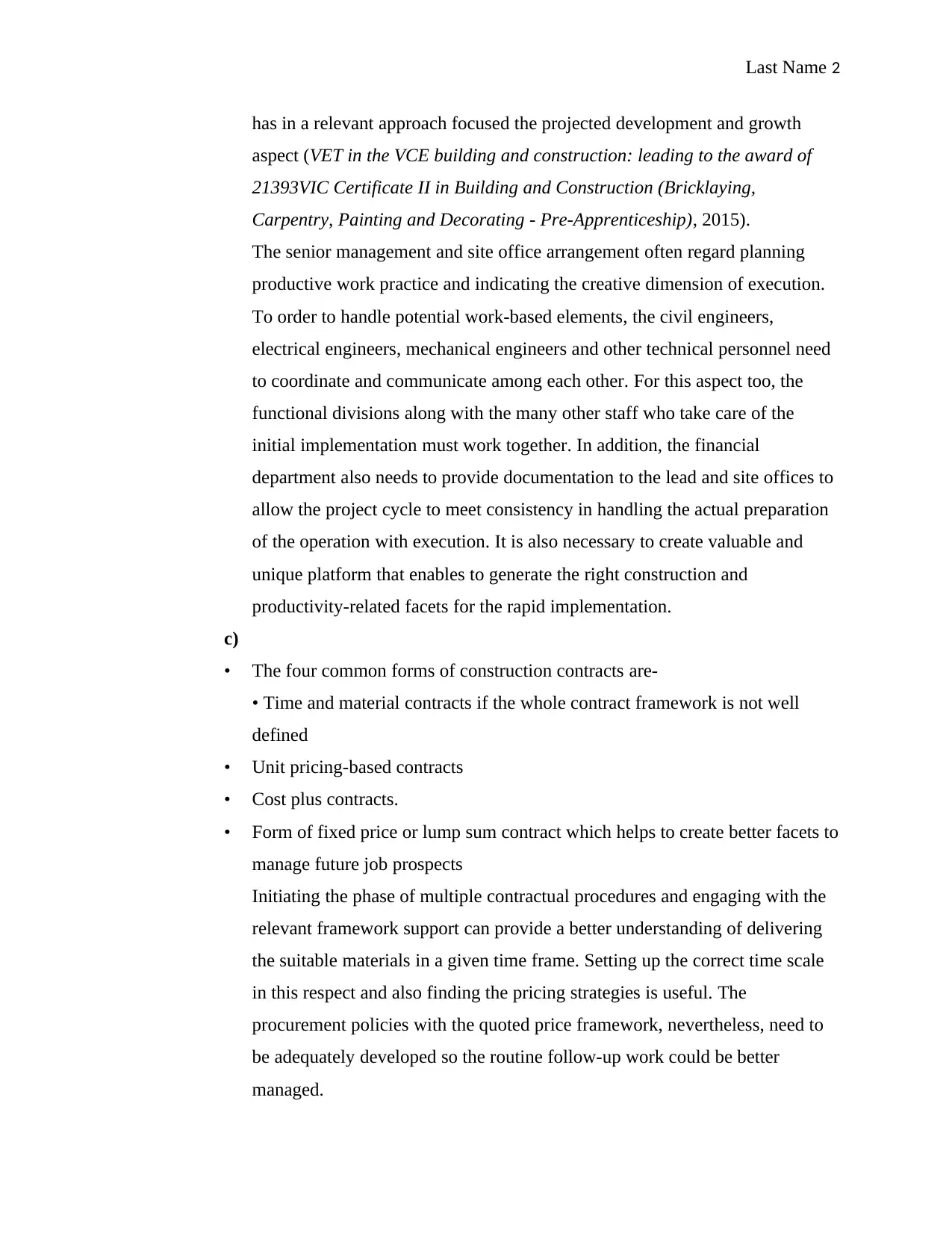
Last Name 2
has in a relevant approach focused the projected development and growth
aspect (VET in the VCE building and construction: leading to the award of
21393VIC Certificate II in Building and Construction (Bricklaying,
Carpentry, Painting and Decorating - Pre-Apprenticeship), 2015).
The senior management and site office arrangement often regard planning
productive work practice and indicating the creative dimension of execution.
To order to handle potential work-based elements, the civil engineers,
electrical engineers, mechanical engineers and other technical personnel need
to coordinate and communicate among each other. For this aspect too, the
functional divisions along with the many other staff who take care of the
initial implementation must work together. In addition, the financial
department also needs to provide documentation to the lead and site offices to
allow the project cycle to meet consistency in handling the actual preparation
of the operation with execution. It is also necessary to create valuable and
unique platform that enables to generate the right construction and
productivity-related facets for the rapid implementation.
c)
• The four common forms of construction contracts are-
• Time and material contracts if the whole contract framework is not well
defined
• Unit pricing-based contracts
• Cost plus contracts.
• Form of fixed price or lump sum contract which helps to create better facets to
manage future job prospects
Initiating the phase of multiple contractual procedures and engaging with the
relevant framework support can provide a better understanding of delivering
the suitable materials in a given time frame. Setting up the correct time scale
in this respect and also finding the pricing strategies is useful. The
procurement policies with the quoted price framework, nevertheless, need to
be adequately developed so the routine follow-up work could be better
managed.
has in a relevant approach focused the projected development and growth
aspect (VET in the VCE building and construction: leading to the award of
21393VIC Certificate II in Building and Construction (Bricklaying,
Carpentry, Painting and Decorating - Pre-Apprenticeship), 2015).
The senior management and site office arrangement often regard planning
productive work practice and indicating the creative dimension of execution.
To order to handle potential work-based elements, the civil engineers,
electrical engineers, mechanical engineers and other technical personnel need
to coordinate and communicate among each other. For this aspect too, the
functional divisions along with the many other staff who take care of the
initial implementation must work together. In addition, the financial
department also needs to provide documentation to the lead and site offices to
allow the project cycle to meet consistency in handling the actual preparation
of the operation with execution. It is also necessary to create valuable and
unique platform that enables to generate the right construction and
productivity-related facets for the rapid implementation.
c)
• The four common forms of construction contracts are-
• Time and material contracts if the whole contract framework is not well
defined
• Unit pricing-based contracts
• Cost plus contracts.
• Form of fixed price or lump sum contract which helps to create better facets to
manage future job prospects
Initiating the phase of multiple contractual procedures and engaging with the
relevant framework support can provide a better understanding of delivering
the suitable materials in a given time frame. Setting up the correct time scale
in this respect and also finding the pricing strategies is useful. The
procurement policies with the quoted price framework, nevertheless, need to
be adequately developed so the routine follow-up work could be better
managed.
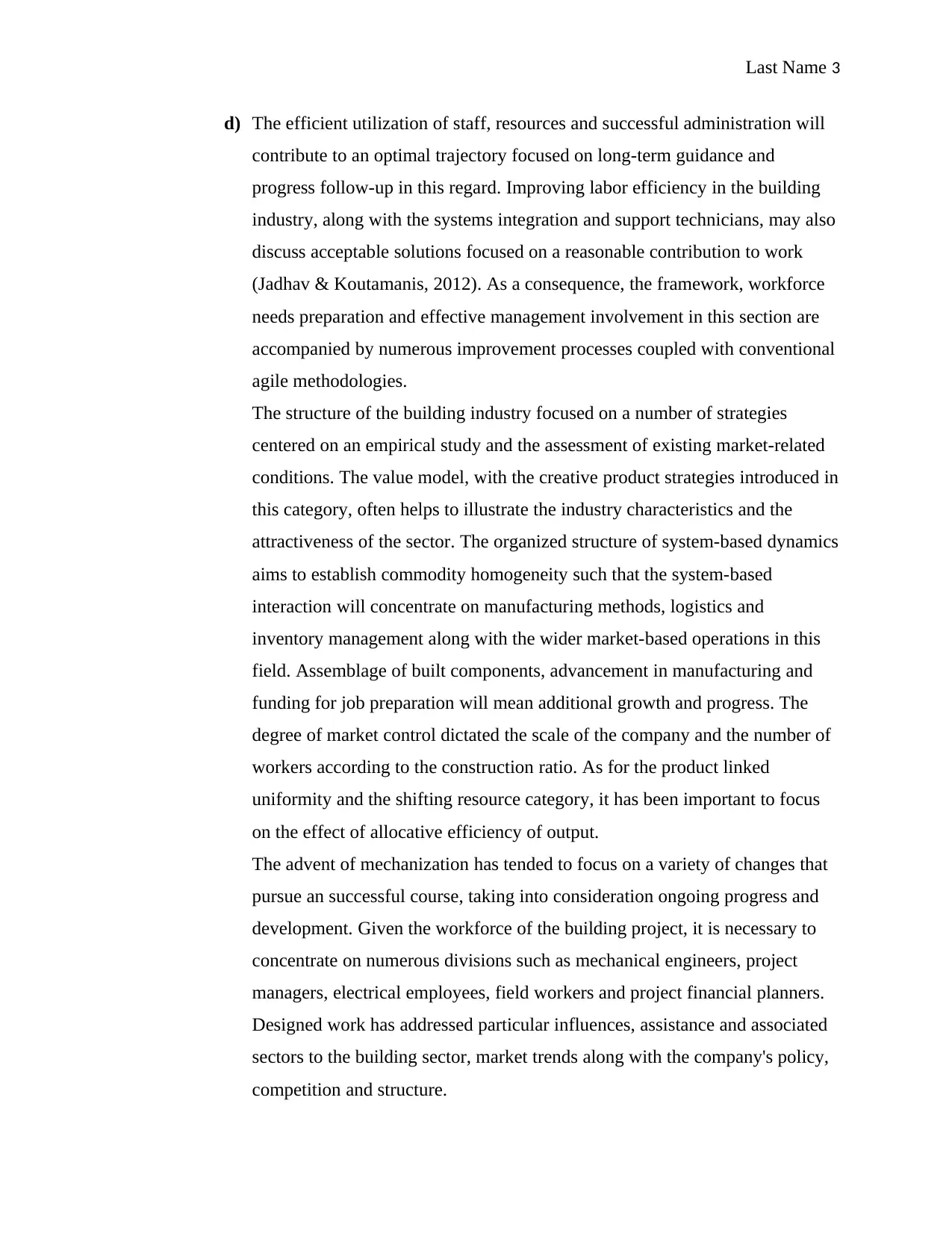
Last Name 3
d) The efficient utilization of staff, resources and successful administration will
contribute to an optimal trajectory focused on long-term guidance and
progress follow-up in this regard. Improving labor efficiency in the building
industry, along with the systems integration and support technicians, may also
discuss acceptable solutions focused on a reasonable contribution to work
(Jadhav & Koutamanis, 2012). As a consequence, the framework, workforce
needs preparation and effective management involvement in this section are
accompanied by numerous improvement processes coupled with conventional
agile methodologies.
The structure of the building industry focused on a number of strategies
centered on an empirical study and the assessment of existing market-related
conditions. The value model, with the creative product strategies introduced in
this category, often helps to illustrate the industry characteristics and the
attractiveness of the sector. The organized structure of system-based dynamics
aims to establish commodity homogeneity such that the system-based
interaction will concentrate on manufacturing methods, logistics and
inventory management along with the wider market-based operations in this
field. Assemblage of built components, advancement in manufacturing and
funding for job preparation will mean additional growth and progress. The
degree of market control dictated the scale of the company and the number of
workers according to the construction ratio. As for the product linked
uniformity and the shifting resource category, it has been important to focus
on the effect of allocative efficiency of output.
The advent of mechanization has tended to focus on a variety of changes that
pursue an successful course, taking into consideration ongoing progress and
development. Given the workforce of the building project, it is necessary to
concentrate on numerous divisions such as mechanical engineers, project
managers, electrical employees, field workers and project financial planners.
Designed work has addressed particular influences, assistance and associated
sectors to the building sector, market trends along with the company's policy,
competition and structure.
d) The efficient utilization of staff, resources and successful administration will
contribute to an optimal trajectory focused on long-term guidance and
progress follow-up in this regard. Improving labor efficiency in the building
industry, along with the systems integration and support technicians, may also
discuss acceptable solutions focused on a reasonable contribution to work
(Jadhav & Koutamanis, 2012). As a consequence, the framework, workforce
needs preparation and effective management involvement in this section are
accompanied by numerous improvement processes coupled with conventional
agile methodologies.
The structure of the building industry focused on a number of strategies
centered on an empirical study and the assessment of existing market-related
conditions. The value model, with the creative product strategies introduced in
this category, often helps to illustrate the industry characteristics and the
attractiveness of the sector. The organized structure of system-based dynamics
aims to establish commodity homogeneity such that the system-based
interaction will concentrate on manufacturing methods, logistics and
inventory management along with the wider market-based operations in this
field. Assemblage of built components, advancement in manufacturing and
funding for job preparation will mean additional growth and progress. The
degree of market control dictated the scale of the company and the number of
workers according to the construction ratio. As for the product linked
uniformity and the shifting resource category, it has been important to focus
on the effect of allocative efficiency of output.
The advent of mechanization has tended to focus on a variety of changes that
pursue an successful course, taking into consideration ongoing progress and
development. Given the workforce of the building project, it is necessary to
concentrate on numerous divisions such as mechanical engineers, project
managers, electrical employees, field workers and project financial planners.
Designed work has addressed particular influences, assistance and associated
sectors to the building sector, market trends along with the company's policy,
competition and structure.
⊘ This is a preview!⊘
Do you want full access?
Subscribe today to unlock all pages.

Trusted by 1+ million students worldwide
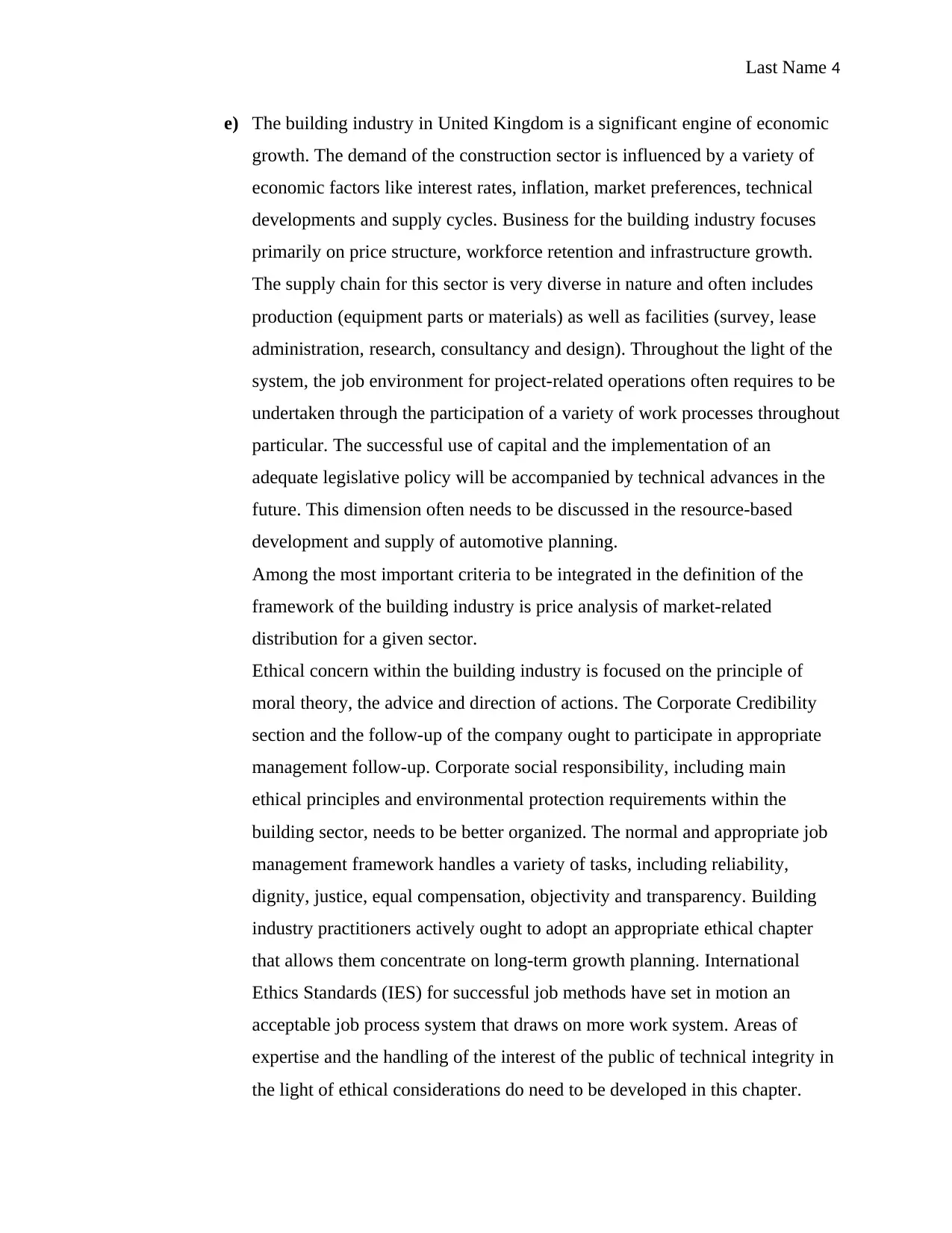
Last Name 4
e) The building industry in United Kingdom is a significant engine of economic
growth. The demand of the construction sector is influenced by a variety of
economic factors like interest rates, inflation, market preferences, technical
developments and supply cycles. Business for the building industry focuses
primarily on price structure, workforce retention and infrastructure growth.
The supply chain for this sector is very diverse in nature and often includes
production (equipment parts or materials) as well as facilities (survey, lease
administration, research, consultancy and design). Throughout the light of the
system, the job environment for project-related operations often requires to be
undertaken through the participation of a variety of work processes throughout
particular. The successful use of capital and the implementation of an
adequate legislative policy will be accompanied by technical advances in the
future. This dimension often needs to be discussed in the resource-based
development and supply of automotive planning.
Among the most important criteria to be integrated in the definition of the
framework of the building industry is price analysis of market-related
distribution for a given sector.
Ethical concern within the building industry is focused on the principle of
moral theory, the advice and direction of actions. The Corporate Credibility
section and the follow-up of the company ought to participate in appropriate
management follow-up. Corporate social responsibility, including main
ethical principles and environmental protection requirements within the
building sector, needs to be better organized. The normal and appropriate job
management framework handles a variety of tasks, including reliability,
dignity, justice, equal compensation, objectivity and transparency. Building
industry practitioners actively ought to adopt an appropriate ethical chapter
that allows them concentrate on long-term growth planning. International
Ethics Standards (IES) for successful job methods have set in motion an
acceptable job process system that draws on more work system. Areas of
expertise and the handling of the interest of the public of technical integrity in
the light of ethical considerations do need to be developed in this chapter.
e) The building industry in United Kingdom is a significant engine of economic
growth. The demand of the construction sector is influenced by a variety of
economic factors like interest rates, inflation, market preferences, technical
developments and supply cycles. Business for the building industry focuses
primarily on price structure, workforce retention and infrastructure growth.
The supply chain for this sector is very diverse in nature and often includes
production (equipment parts or materials) as well as facilities (survey, lease
administration, research, consultancy and design). Throughout the light of the
system, the job environment for project-related operations often requires to be
undertaken through the participation of a variety of work processes throughout
particular. The successful use of capital and the implementation of an
adequate legislative policy will be accompanied by technical advances in the
future. This dimension often needs to be discussed in the resource-based
development and supply of automotive planning.
Among the most important criteria to be integrated in the definition of the
framework of the building industry is price analysis of market-related
distribution for a given sector.
Ethical concern within the building industry is focused on the principle of
moral theory, the advice and direction of actions. The Corporate Credibility
section and the follow-up of the company ought to participate in appropriate
management follow-up. Corporate social responsibility, including main
ethical principles and environmental protection requirements within the
building sector, needs to be better organized. The normal and appropriate job
management framework handles a variety of tasks, including reliability,
dignity, justice, equal compensation, objectivity and transparency. Building
industry practitioners actively ought to adopt an appropriate ethical chapter
that allows them concentrate on long-term growth planning. International
Ethics Standards (IES) for successful job methods have set in motion an
acceptable job process system that draws on more work system. Areas of
expertise and the handling of the interest of the public of technical integrity in
the light of ethical considerations do need to be developed in this chapter.
Paraphrase This Document
Need a fresh take? Get an instant paraphrase of this document with our AI Paraphraser
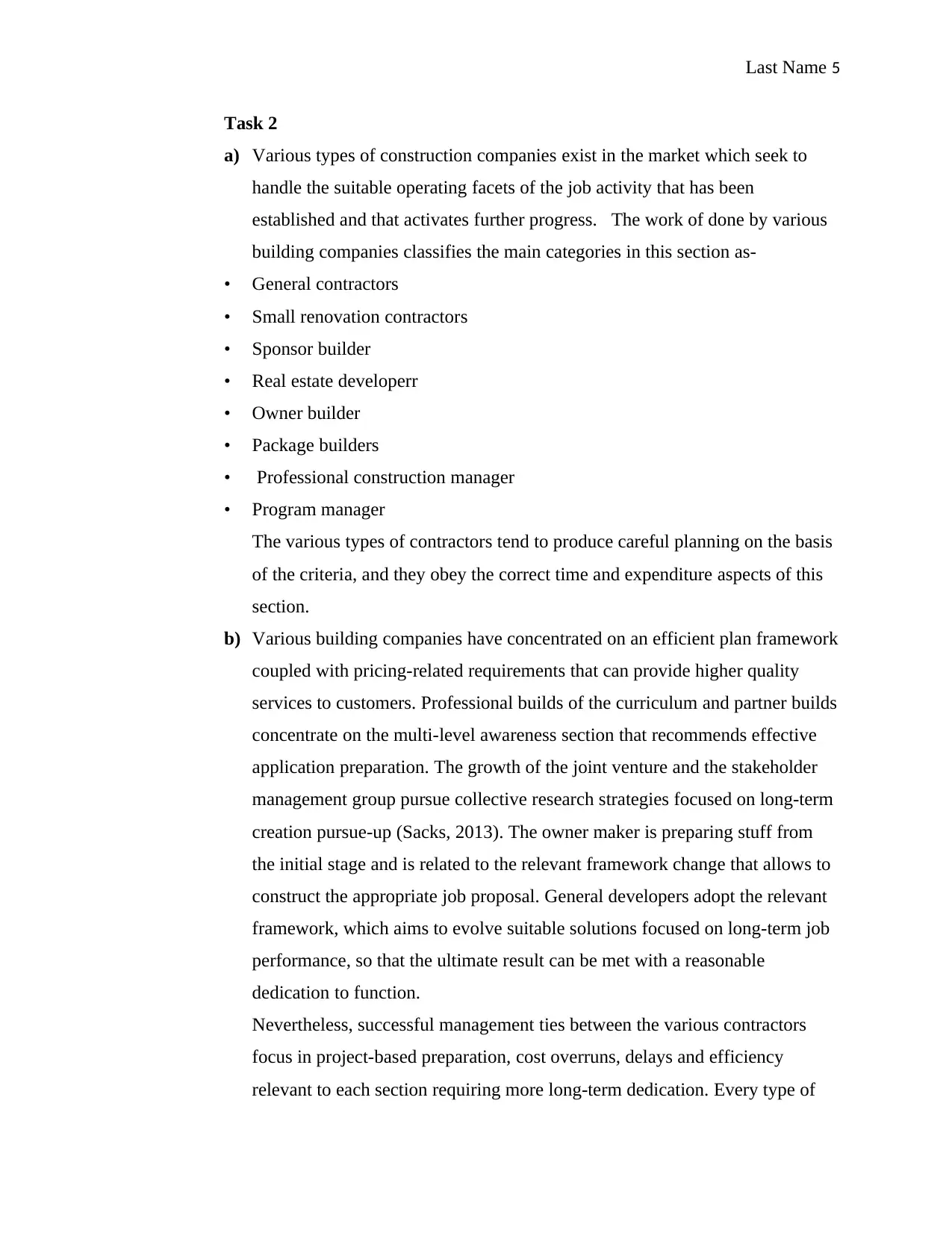
Last Name 5
Task 2
a) Various types of construction companies exist in the market which seek to
handle the suitable operating facets of the job activity that has been
established and that activates further progress. The work of done by various
building companies classifies the main categories in this section as-
• General contractors
• Small renovation contractors
• Sponsor builder
• Real estate developerr
• Owner builder
• Package builders
• Professional construction manager
• Program manager
The various types of contractors tend to produce careful planning on the basis
of the criteria, and they obey the correct time and expenditure aspects of this
section.
b) Various building companies have concentrated on an efficient plan framework
coupled with pricing-related requirements that can provide higher quality
services to customers. Professional builds of the curriculum and partner builds
concentrate on the multi-level awareness section that recommends effective
application preparation. The growth of the joint venture and the stakeholder
management group pursue collective research strategies focused on long-term
creation pursue-up (Sacks, 2013). The owner maker is preparing stuff from
the initial stage and is related to the relevant framework change that allows to
construct the appropriate job proposal. General developers adopt the relevant
framework, which aims to evolve suitable solutions focused on long-term job
performance, so that the ultimate result can be met with a reasonable
dedication to function.
Nevertheless, successful management ties between the various contractors
focus in project-based preparation, cost overruns, delays and efficiency
relevant to each section requiring more long-term dedication. Every type of
Task 2
a) Various types of construction companies exist in the market which seek to
handle the suitable operating facets of the job activity that has been
established and that activates further progress. The work of done by various
building companies classifies the main categories in this section as-
• General contractors
• Small renovation contractors
• Sponsor builder
• Real estate developerr
• Owner builder
• Package builders
• Professional construction manager
• Program manager
The various types of contractors tend to produce careful planning on the basis
of the criteria, and they obey the correct time and expenditure aspects of this
section.
b) Various building companies have concentrated on an efficient plan framework
coupled with pricing-related requirements that can provide higher quality
services to customers. Professional builds of the curriculum and partner builds
concentrate on the multi-level awareness section that recommends effective
application preparation. The growth of the joint venture and the stakeholder
management group pursue collective research strategies focused on long-term
creation pursue-up (Sacks, 2013). The owner maker is preparing stuff from
the initial stage and is related to the relevant framework change that allows to
construct the appropriate job proposal. General developers adopt the relevant
framework, which aims to evolve suitable solutions focused on long-term job
performance, so that the ultimate result can be met with a reasonable
dedication to function.
Nevertheless, successful management ties between the various contractors
focus in project-based preparation, cost overruns, delays and efficiency
relevant to each section requiring more long-term dedication. Every type of
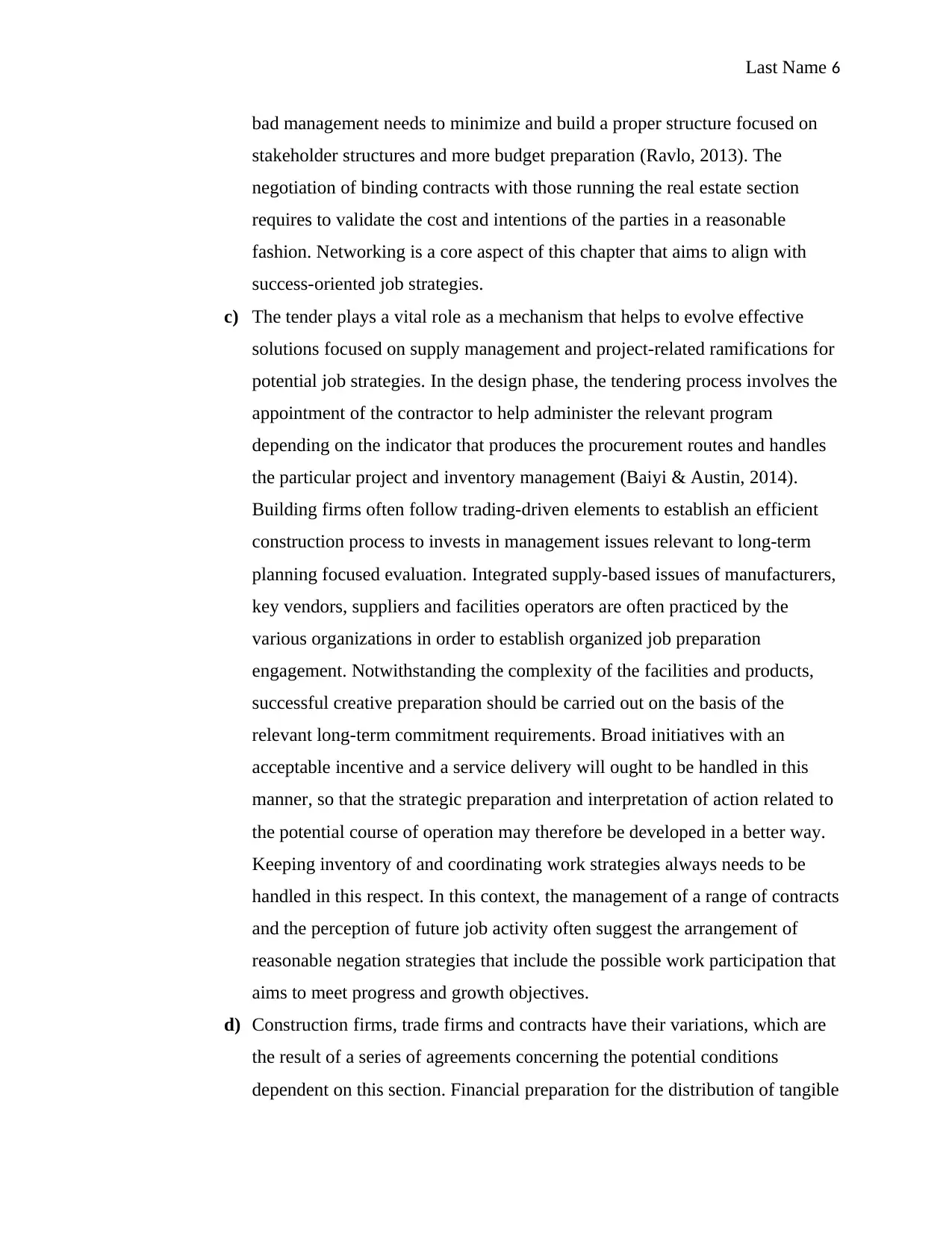
Last Name 6
bad management needs to minimize and build a proper structure focused on
stakeholder structures and more budget preparation (Ravlo, 2013). The
negotiation of binding contracts with those running the real estate section
requires to validate the cost and intentions of the parties in a reasonable
fashion. Networking is a core aspect of this chapter that aims to align with
success-oriented job strategies.
c) The tender plays a vital role as a mechanism that helps to evolve effective
solutions focused on supply management and project-related ramifications for
potential job strategies. In the design phase, the tendering process involves the
appointment of the contractor to help administer the relevant program
depending on the indicator that produces the procurement routes and handles
the particular project and inventory management (Baiyi & Austin, 2014).
Building firms often follow trading-driven elements to establish an efficient
construction process to invests in management issues relevant to long-term
planning focused evaluation. Integrated supply-based issues of manufacturers,
key vendors, suppliers and facilities operators are often practiced by the
various organizations in order to establish organized job preparation
engagement. Notwithstanding the complexity of the facilities and products,
successful creative preparation should be carried out on the basis of the
relevant long-term commitment requirements. Broad initiatives with an
acceptable incentive and a service delivery will ought to be handled in this
manner, so that the strategic preparation and interpretation of action related to
the potential course of operation may therefore be developed in a better way.
Keeping inventory of and coordinating work strategies always needs to be
handled in this respect. In this context, the management of a range of contracts
and the perception of future job activity often suggest the arrangement of
reasonable negation strategies that include the possible work participation that
aims to meet progress and growth objectives.
d) Construction firms, trade firms and contracts have their variations, which are
the result of a series of agreements concerning the potential conditions
dependent on this section. Financial preparation for the distribution of tangible
bad management needs to minimize and build a proper structure focused on
stakeholder structures and more budget preparation (Ravlo, 2013). The
negotiation of binding contracts with those running the real estate section
requires to validate the cost and intentions of the parties in a reasonable
fashion. Networking is a core aspect of this chapter that aims to align with
success-oriented job strategies.
c) The tender plays a vital role as a mechanism that helps to evolve effective
solutions focused on supply management and project-related ramifications for
potential job strategies. In the design phase, the tendering process involves the
appointment of the contractor to help administer the relevant program
depending on the indicator that produces the procurement routes and handles
the particular project and inventory management (Baiyi & Austin, 2014).
Building firms often follow trading-driven elements to establish an efficient
construction process to invests in management issues relevant to long-term
planning focused evaluation. Integrated supply-based issues of manufacturers,
key vendors, suppliers and facilities operators are often practiced by the
various organizations in order to establish organized job preparation
engagement. Notwithstanding the complexity of the facilities and products,
successful creative preparation should be carried out on the basis of the
relevant long-term commitment requirements. Broad initiatives with an
acceptable incentive and a service delivery will ought to be handled in this
manner, so that the strategic preparation and interpretation of action related to
the potential course of operation may therefore be developed in a better way.
Keeping inventory of and coordinating work strategies always needs to be
handled in this respect. In this context, the management of a range of contracts
and the perception of future job activity often suggest the arrangement of
reasonable negation strategies that include the possible work participation that
aims to meet progress and growth objectives.
d) Construction firms, trade firms and contracts have their variations, which are
the result of a series of agreements concerning the potential conditions
dependent on this section. Financial preparation for the distribution of tangible
⊘ This is a preview!⊘
Do you want full access?
Subscribe today to unlock all pages.

Trusted by 1+ million students worldwide
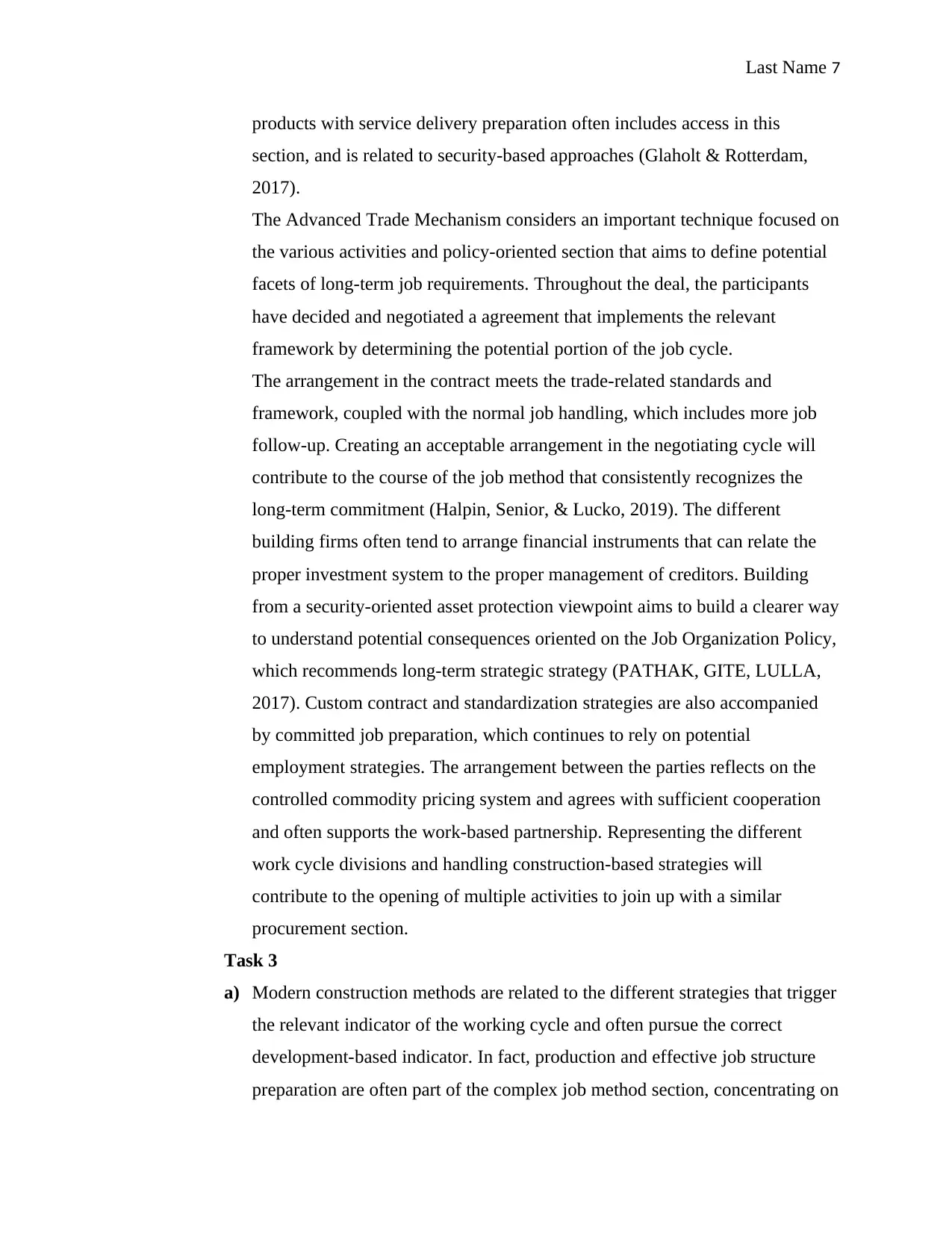
Last Name 7
products with service delivery preparation often includes access in this
section, and is related to security-based approaches (Glaholt & Rotterdam,
2017).
The Advanced Trade Mechanism considers an important technique focused on
the various activities and policy-oriented section that aims to define potential
facets of long-term job requirements. Throughout the deal, the participants
have decided and negotiated a agreement that implements the relevant
framework by determining the potential portion of the job cycle.
The arrangement in the contract meets the trade-related standards and
framework, coupled with the normal job handling, which includes more job
follow-up. Creating an acceptable arrangement in the negotiating cycle will
contribute to the course of the job method that consistently recognizes the
long-term commitment (Halpin, Senior, & Lucko, 2019). The different
building firms often tend to arrange financial instruments that can relate the
proper investment system to the proper management of creditors. Building
from a security-oriented asset protection viewpoint aims to build a clearer way
to understand potential consequences oriented on the Job Organization Policy,
which recommends long-term strategic strategy (PATHAK, GITE, LULLA,
2017). Custom contract and standardization strategies are also accompanied
by committed job preparation, which continues to rely on potential
employment strategies. The arrangement between the parties reflects on the
controlled commodity pricing system and agrees with sufficient cooperation
and often supports the work-based partnership. Representing the different
work cycle divisions and handling construction-based strategies will
contribute to the opening of multiple activities to join up with a similar
procurement section.
Task 3
a) Modern construction methods are related to the different strategies that trigger
the relevant indicator of the working cycle and often pursue the correct
development-based indicator. In fact, production and effective job structure
preparation are often part of the complex job method section, concentrating on
products with service delivery preparation often includes access in this
section, and is related to security-based approaches (Glaholt & Rotterdam,
2017).
The Advanced Trade Mechanism considers an important technique focused on
the various activities and policy-oriented section that aims to define potential
facets of long-term job requirements. Throughout the deal, the participants
have decided and negotiated a agreement that implements the relevant
framework by determining the potential portion of the job cycle.
The arrangement in the contract meets the trade-related standards and
framework, coupled with the normal job handling, which includes more job
follow-up. Creating an acceptable arrangement in the negotiating cycle will
contribute to the course of the job method that consistently recognizes the
long-term commitment (Halpin, Senior, & Lucko, 2019). The different
building firms often tend to arrange financial instruments that can relate the
proper investment system to the proper management of creditors. Building
from a security-oriented asset protection viewpoint aims to build a clearer way
to understand potential consequences oriented on the Job Organization Policy,
which recommends long-term strategic strategy (PATHAK, GITE, LULLA,
2017). Custom contract and standardization strategies are also accompanied
by committed job preparation, which continues to rely on potential
employment strategies. The arrangement between the parties reflects on the
controlled commodity pricing system and agrees with sufficient cooperation
and often supports the work-based partnership. Representing the different
work cycle divisions and handling construction-based strategies will
contribute to the opening of multiple activities to join up with a similar
procurement section.
Task 3
a) Modern construction methods are related to the different strategies that trigger
the relevant indicator of the working cycle and often pursue the correct
development-based indicator. In fact, production and effective job structure
preparation are often part of the complex job method section, concentrating on
Paraphrase This Document
Need a fresh take? Get an instant paraphrase of this document with our AI Paraphraser
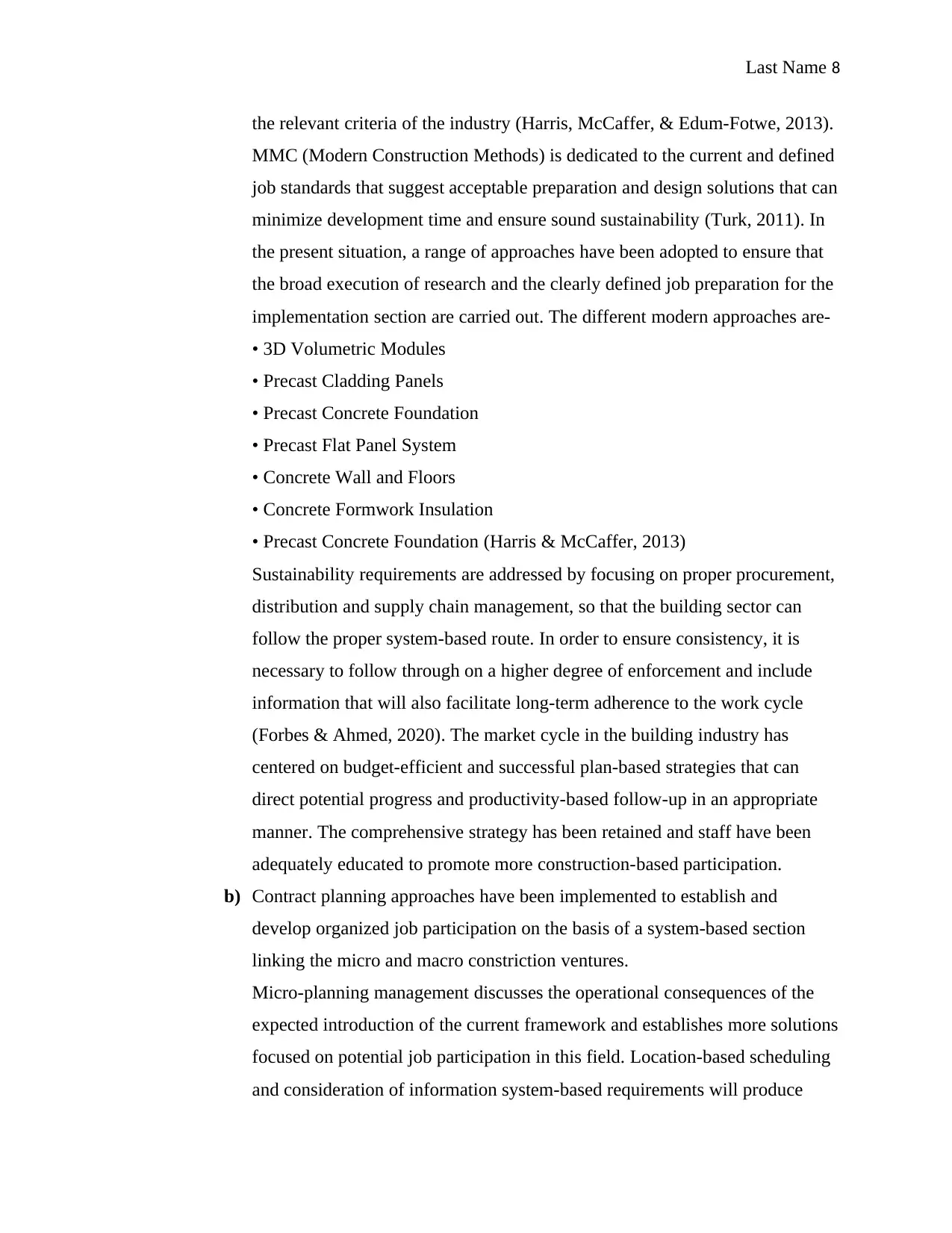
Last Name 8
the relevant criteria of the industry (Harris, McCaffer, & Edum-Fotwe, 2013).
MMC (Modern Construction Methods) is dedicated to the current and defined
job standards that suggest acceptable preparation and design solutions that can
minimize development time and ensure sound sustainability (Turk, 2011). In
the present situation, a range of approaches have been adopted to ensure that
the broad execution of research and the clearly defined job preparation for the
implementation section are carried out. The different modern approaches are-
• 3D Volumetric Modules
• Precast Cladding Panels
• Precast Concrete Foundation
• Precast Flat Panel System
• Concrete Wall and Floors
• Concrete Formwork Insulation
• Precast Concrete Foundation (Harris & McCaffer, 2013)
Sustainability requirements are addressed by focusing on proper procurement,
distribution and supply chain management, so that the building sector can
follow the proper system-based route. In order to ensure consistency, it is
necessary to follow through on a higher degree of enforcement and include
information that will also facilitate long-term adherence to the work cycle
(Forbes & Ahmed, 2020). The market cycle in the building industry has
centered on budget-efficient and successful plan-based strategies that can
direct potential progress and productivity-based follow-up in an appropriate
manner. The comprehensive strategy has been retained and staff have been
adequately educated to promote more construction-based participation.
b) Contract planning approaches have been implemented to establish and
develop organized job participation on the basis of a system-based section
linking the micro and macro constriction ventures.
Micro-planning management discusses the operational consequences of the
expected introduction of the current framework and establishes more solutions
focused on potential job participation in this field. Location-based scheduling
and consideration of information system-based requirements will produce
the relevant criteria of the industry (Harris, McCaffer, & Edum-Fotwe, 2013).
MMC (Modern Construction Methods) is dedicated to the current and defined
job standards that suggest acceptable preparation and design solutions that can
minimize development time and ensure sound sustainability (Turk, 2011). In
the present situation, a range of approaches have been adopted to ensure that
the broad execution of research and the clearly defined job preparation for the
implementation section are carried out. The different modern approaches are-
• 3D Volumetric Modules
• Precast Cladding Panels
• Precast Concrete Foundation
• Precast Flat Panel System
• Concrete Wall and Floors
• Concrete Formwork Insulation
• Precast Concrete Foundation (Harris & McCaffer, 2013)
Sustainability requirements are addressed by focusing on proper procurement,
distribution and supply chain management, so that the building sector can
follow the proper system-based route. In order to ensure consistency, it is
necessary to follow through on a higher degree of enforcement and include
information that will also facilitate long-term adherence to the work cycle
(Forbes & Ahmed, 2020). The market cycle in the building industry has
centered on budget-efficient and successful plan-based strategies that can
direct potential progress and productivity-based follow-up in an appropriate
manner. The comprehensive strategy has been retained and staff have been
adequately educated to promote more construction-based participation.
b) Contract planning approaches have been implemented to establish and
develop organized job participation on the basis of a system-based section
linking the micro and macro constriction ventures.
Micro-planning management discusses the operational consequences of the
expected introduction of the current framework and establishes more solutions
focused on potential job participation in this field. Location-based scheduling
and consideration of information system-based requirements will produce
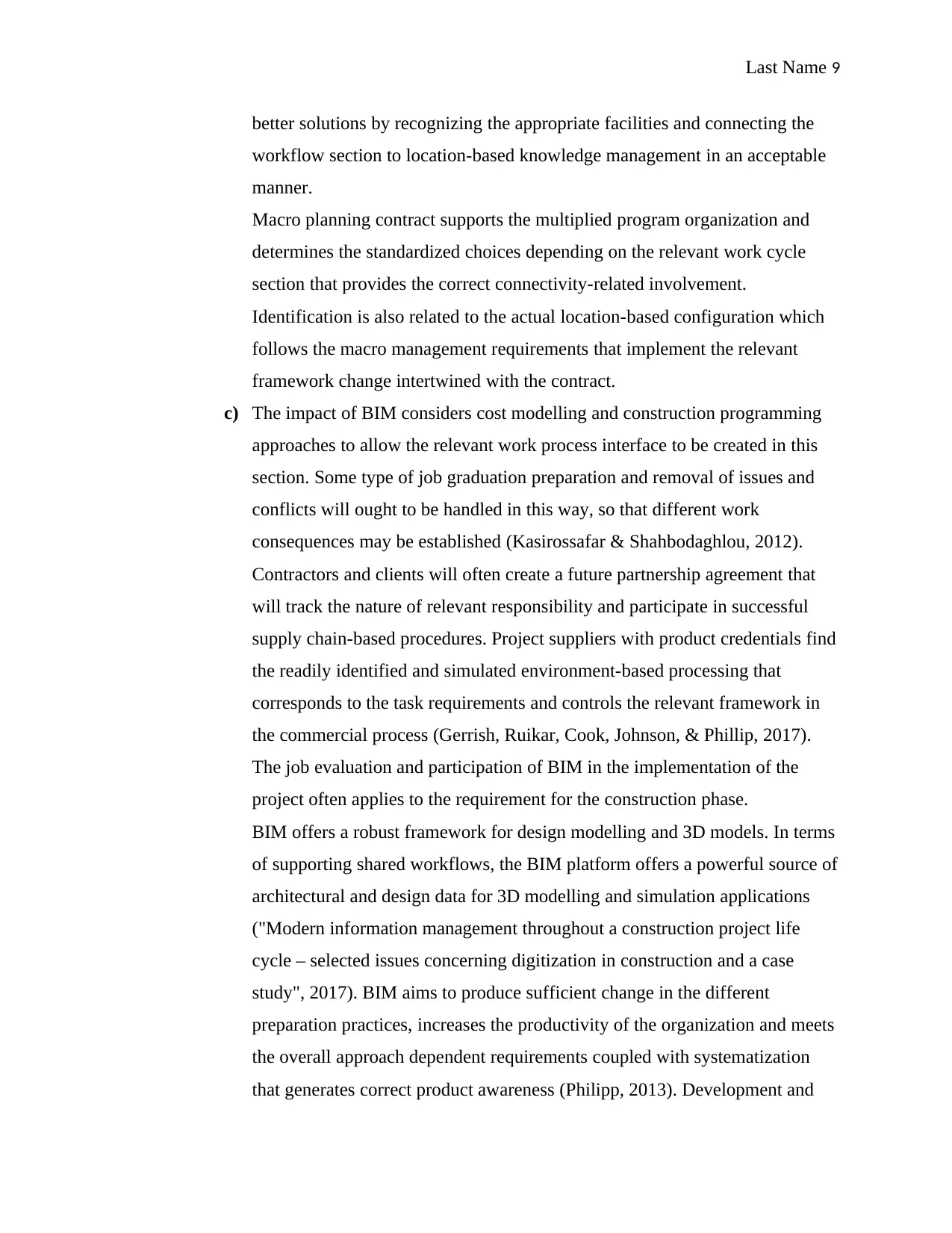
Last Name 9
better solutions by recognizing the appropriate facilities and connecting the
workflow section to location-based knowledge management in an acceptable
manner.
Macro planning contract supports the multiplied program organization and
determines the standardized choices depending on the relevant work cycle
section that provides the correct connectivity-related involvement.
Identification is also related to the actual location-based configuration which
follows the macro management requirements that implement the relevant
framework change intertwined with the contract.
c) The impact of BIM considers cost modelling and construction programming
approaches to allow the relevant work process interface to be created in this
section. Some type of job graduation preparation and removal of issues and
conflicts will ought to be handled in this way, so that different work
consequences may be established (Kasirossafar & Shahbodaghlou, 2012).
Contractors and clients will often create a future partnership agreement that
will track the nature of relevant responsibility and participate in successful
supply chain-based procedures. Project suppliers with product credentials find
the readily identified and simulated environment-based processing that
corresponds to the task requirements and controls the relevant framework in
the commercial process (Gerrish, Ruikar, Cook, Johnson, & Phillip, 2017).
The job evaluation and participation of BIM in the implementation of the
project often applies to the requirement for the construction phase.
BIM offers a robust framework for design modelling and 3D models. In terms
of supporting shared workflows, the BIM platform offers a powerful source of
architectural and design data for 3D modelling and simulation applications
("Modern information management throughout a construction project life
cycle – selected issues concerning digitization in construction and a case
study", 2017). BIM aims to produce sufficient change in the different
preparation practices, increases the productivity of the organization and meets
the overall approach dependent requirements coupled with systematization
that generates correct product awareness (Philipp, 2013). Development and
better solutions by recognizing the appropriate facilities and connecting the
workflow section to location-based knowledge management in an acceptable
manner.
Macro planning contract supports the multiplied program organization and
determines the standardized choices depending on the relevant work cycle
section that provides the correct connectivity-related involvement.
Identification is also related to the actual location-based configuration which
follows the macro management requirements that implement the relevant
framework change intertwined with the contract.
c) The impact of BIM considers cost modelling and construction programming
approaches to allow the relevant work process interface to be created in this
section. Some type of job graduation preparation and removal of issues and
conflicts will ought to be handled in this way, so that different work
consequences may be established (Kasirossafar & Shahbodaghlou, 2012).
Contractors and clients will often create a future partnership agreement that
will track the nature of relevant responsibility and participate in successful
supply chain-based procedures. Project suppliers with product credentials find
the readily identified and simulated environment-based processing that
corresponds to the task requirements and controls the relevant framework in
the commercial process (Gerrish, Ruikar, Cook, Johnson, & Phillip, 2017).
The job evaluation and participation of BIM in the implementation of the
project often applies to the requirement for the construction phase.
BIM offers a robust framework for design modelling and 3D models. In terms
of supporting shared workflows, the BIM platform offers a powerful source of
architectural and design data for 3D modelling and simulation applications
("Modern information management throughout a construction project life
cycle – selected issues concerning digitization in construction and a case
study", 2017). BIM aims to produce sufficient change in the different
preparation practices, increases the productivity of the organization and meets
the overall approach dependent requirements coupled with systematization
that generates correct product awareness (Philipp, 2013). Development and
⊘ This is a preview!⊘
Do you want full access?
Subscribe today to unlock all pages.

Trusted by 1+ million students worldwide
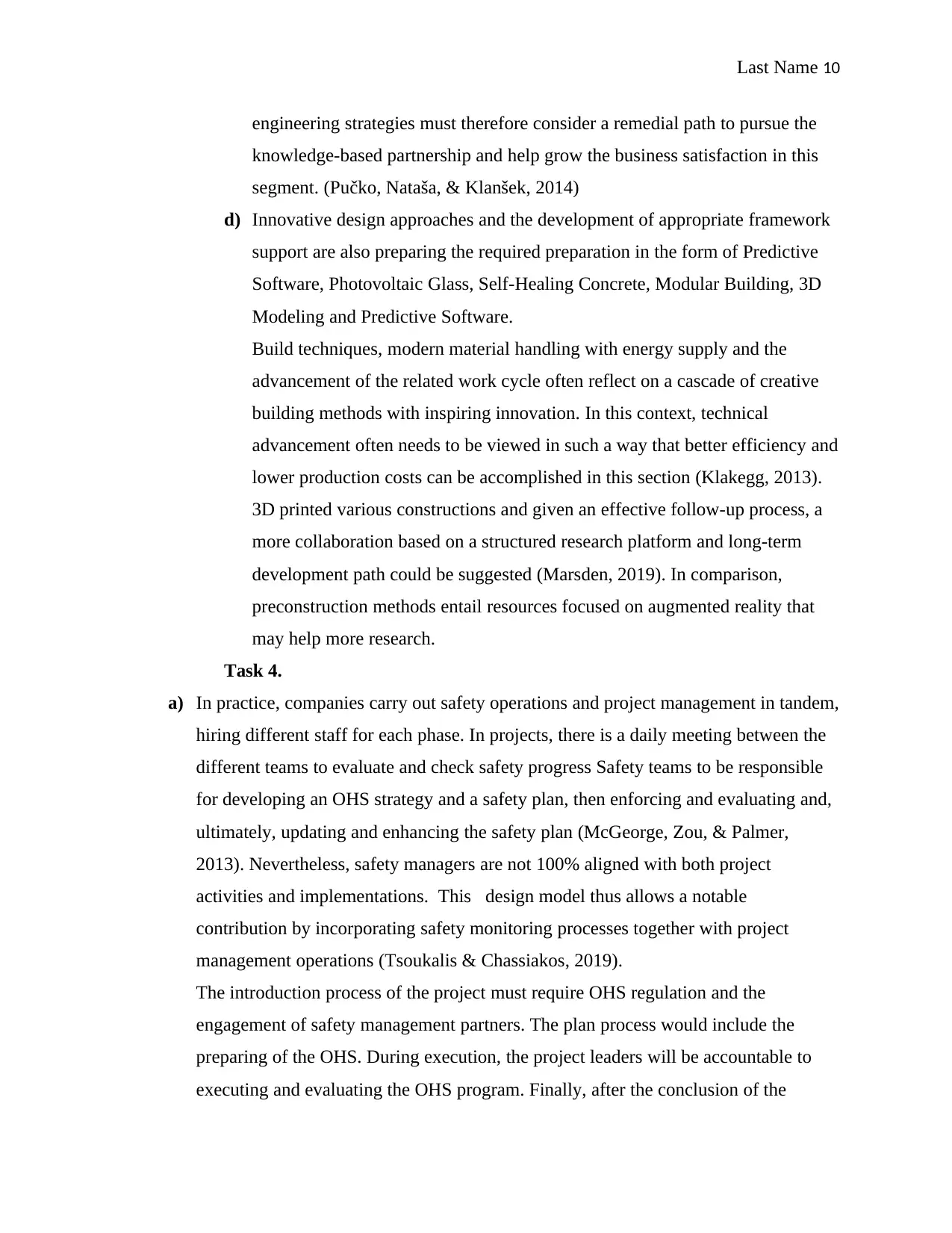
Last Name 10
engineering strategies must therefore consider a remedial path to pursue the
knowledge-based partnership and help grow the business satisfaction in this
segment. (Pučko, Nataša, & Klanšek, 2014)
d) Innovative design approaches and the development of appropriate framework
support are also preparing the required preparation in the form of Predictive
Software, Photovoltaic Glass, Self-Healing Concrete, Modular Building, 3D
Modeling and Predictive Software.
Build techniques, modern material handling with energy supply and the
advancement of the related work cycle often reflect on a cascade of creative
building methods with inspiring innovation. In this context, technical
advancement often needs to be viewed in such a way that better efficiency and
lower production costs can be accomplished in this section (Klakegg, 2013).
3D printed various constructions and given an effective follow-up process, a
more collaboration based on a structured research platform and long-term
development path could be suggested (Marsden, 2019). In comparison,
preconstruction methods entail resources focused on augmented reality that
may help more research.
Task 4.
a) In practice, companies carry out safety operations and project management in tandem,
hiring different staff for each phase. In projects, there is a daily meeting between the
different teams to evaluate and check safety progress Safety teams to be responsible
for developing an OHS strategy and a safety plan, then enforcing and evaluating and,
ultimately, updating and enhancing the safety plan (McGeorge, Zou, & Palmer,
2013). Nevertheless, safety managers are not 100% aligned with both project
activities and implementations. This design model thus allows a notable
contribution by incorporating safety monitoring processes together with project
management operations (Tsoukalis & Chassiakos, 2019).
The introduction process of the project must require OHS regulation and the
engagement of safety management partners. The plan process would include the
preparing of the OHS. During execution, the project leaders will be accountable to
executing and evaluating the OHS program. Finally, after the conclusion of the
engineering strategies must therefore consider a remedial path to pursue the
knowledge-based partnership and help grow the business satisfaction in this
segment. (Pučko, Nataša, & Klanšek, 2014)
d) Innovative design approaches and the development of appropriate framework
support are also preparing the required preparation in the form of Predictive
Software, Photovoltaic Glass, Self-Healing Concrete, Modular Building, 3D
Modeling and Predictive Software.
Build techniques, modern material handling with energy supply and the
advancement of the related work cycle often reflect on a cascade of creative
building methods with inspiring innovation. In this context, technical
advancement often needs to be viewed in such a way that better efficiency and
lower production costs can be accomplished in this section (Klakegg, 2013).
3D printed various constructions and given an effective follow-up process, a
more collaboration based on a structured research platform and long-term
development path could be suggested (Marsden, 2019). In comparison,
preconstruction methods entail resources focused on augmented reality that
may help more research.
Task 4.
a) In practice, companies carry out safety operations and project management in tandem,
hiring different staff for each phase. In projects, there is a daily meeting between the
different teams to evaluate and check safety progress Safety teams to be responsible
for developing an OHS strategy and a safety plan, then enforcing and evaluating and,
ultimately, updating and enhancing the safety plan (McGeorge, Zou, & Palmer,
2013). Nevertheless, safety managers are not 100% aligned with both project
activities and implementations. This design model thus allows a notable
contribution by incorporating safety monitoring processes together with project
management operations (Tsoukalis & Chassiakos, 2019).
The introduction process of the project must require OHS regulation and the
engagement of safety management partners. The plan process would include the
preparing of the OHS. During execution, the project leaders will be accountable to
executing and evaluating the OHS program. Finally, after the conclusion of the
Paraphrase This Document
Need a fresh take? Get an instant paraphrase of this document with our AI Paraphraser
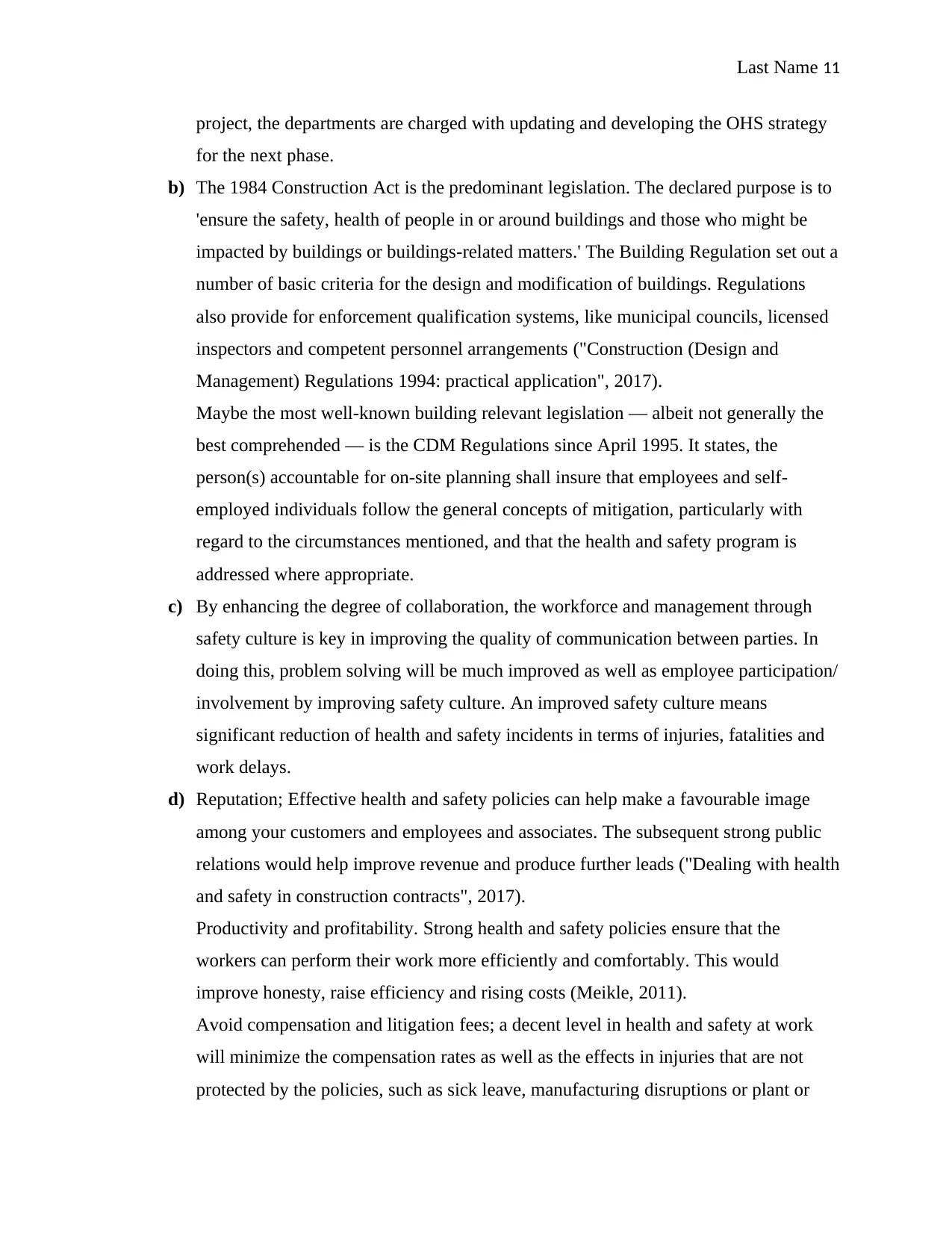
Last Name 11
project, the departments are charged with updating and developing the OHS strategy
for the next phase.
b) The 1984 Construction Act is the predominant legislation. The declared purpose is to
'ensure the safety, health of people in or around buildings and those who might be
impacted by buildings or buildings-related matters.' The Building Regulation set out a
number of basic criteria for the design and modification of buildings. Regulations
also provide for enforcement qualification systems, like municipal councils, licensed
inspectors and competent personnel arrangements ("Construction (Design and
Management) Regulations 1994: practical application", 2017).
Maybe the most well-known building relevant legislation — albeit not generally the
best comprehended — is the CDM Regulations since April 1995. It states, the
person(s) accountable for on-site planning shall insure that employees and self-
employed individuals follow the general concepts of mitigation, particularly with
regard to the circumstances mentioned, and that the health and safety program is
addressed where appropriate.
c) By enhancing the degree of collaboration, the workforce and management through
safety culture is key in improving the quality of communication between parties. In
doing this, problem solving will be much improved as well as employee participation/
involvement by improving safety culture. An improved safety culture means
significant reduction of health and safety incidents in terms of injuries, fatalities and
work delays.
d) Reputation; Effective health and safety policies can help make a favourable image
among your customers and employees and associates. The subsequent strong public
relations would help improve revenue and produce further leads ("Dealing with health
and safety in construction contracts", 2017).
Productivity and profitability. Strong health and safety policies ensure that the
workers can perform their work more efficiently and comfortably. This would
improve honesty, raise efficiency and rising costs (Meikle, 2011).
Avoid compensation and litigation fees; a decent level in health and safety at work
will minimize the compensation rates as well as the effects in injuries that are not
protected by the policies, such as sick leave, manufacturing disruptions or plant or
project, the departments are charged with updating and developing the OHS strategy
for the next phase.
b) The 1984 Construction Act is the predominant legislation. The declared purpose is to
'ensure the safety, health of people in or around buildings and those who might be
impacted by buildings or buildings-related matters.' The Building Regulation set out a
number of basic criteria for the design and modification of buildings. Regulations
also provide for enforcement qualification systems, like municipal councils, licensed
inspectors and competent personnel arrangements ("Construction (Design and
Management) Regulations 1994: practical application", 2017).
Maybe the most well-known building relevant legislation — albeit not generally the
best comprehended — is the CDM Regulations since April 1995. It states, the
person(s) accountable for on-site planning shall insure that employees and self-
employed individuals follow the general concepts of mitigation, particularly with
regard to the circumstances mentioned, and that the health and safety program is
addressed where appropriate.
c) By enhancing the degree of collaboration, the workforce and management through
safety culture is key in improving the quality of communication between parties. In
doing this, problem solving will be much improved as well as employee participation/
involvement by improving safety culture. An improved safety culture means
significant reduction of health and safety incidents in terms of injuries, fatalities and
work delays.
d) Reputation; Effective health and safety policies can help make a favourable image
among your customers and employees and associates. The subsequent strong public
relations would help improve revenue and produce further leads ("Dealing with health
and safety in construction contracts", 2017).
Productivity and profitability. Strong health and safety policies ensure that the
workers can perform their work more efficiently and comfortably. This would
improve honesty, raise efficiency and rising costs (Meikle, 2011).
Avoid compensation and litigation fees; a decent level in health and safety at work
will minimize the compensation rates as well as the effects in injuries that are not
protected by the policies, such as sick leave, manufacturing disruptions or plant or
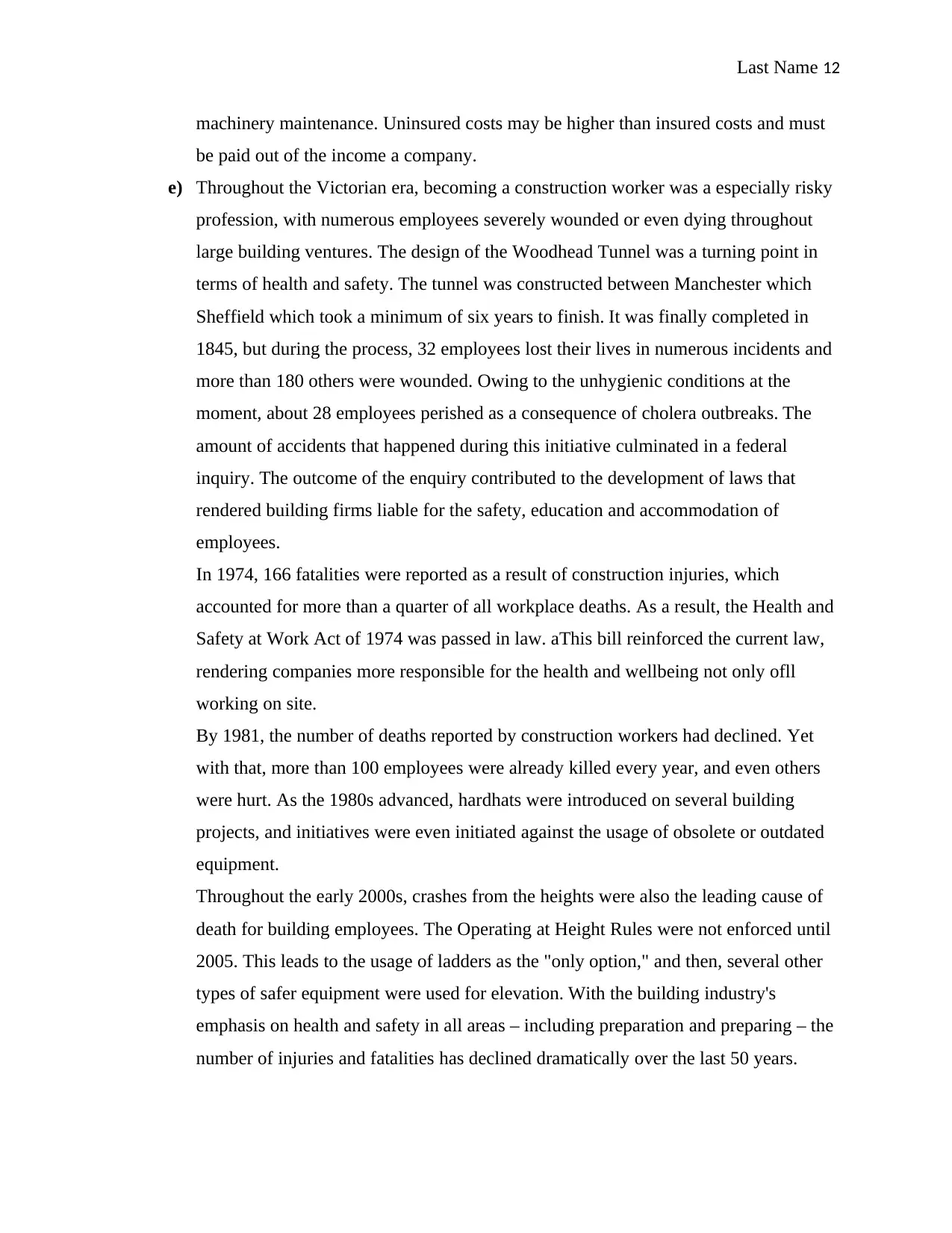
Last Name 12
machinery maintenance. Uninsured costs may be higher than insured costs and must
be paid out of the income a company.
e) Throughout the Victorian era, becoming a construction worker was a especially risky
profession, with numerous employees severely wounded or even dying throughout
large building ventures. The design of the Woodhead Tunnel was a turning point in
terms of health and safety. The tunnel was constructed between Manchester which
Sheffield which took a minimum of six years to finish. It was finally completed in
1845, but during the process, 32 employees lost their lives in numerous incidents and
more than 180 others were wounded. Owing to the unhygienic conditions at the
moment, about 28 employees perished as a consequence of cholera outbreaks. The
amount of accidents that happened during this initiative culminated in a federal
inquiry. The outcome of the enquiry contributed to the development of laws that
rendered building firms liable for the safety, education and accommodation of
employees.
In 1974, 166 fatalities were reported as a result of construction injuries, which
accounted for more than a quarter of all workplace deaths. As a result, the Health and
Safety at Work Act of 1974 was passed in law. aThis bill reinforced the current law,
rendering companies more responsible for the health and wellbeing not only ofll
working on site.
By 1981, the number of deaths reported by construction workers had declined. Yet
with that, more than 100 employees were already killed every year, and even others
were hurt. As the 1980s advanced, hardhats were introduced on several building
projects, and initiatives were even initiated against the usage of obsolete or outdated
equipment.
Throughout the early 2000s, crashes from the heights were also the leading cause of
death for building employees. The Operating at Height Rules were not enforced until
2005. This leads to the usage of ladders as the "only option," and then, several other
types of safer equipment were used for elevation. With the building industry's
emphasis on health and safety in all areas – including preparation and preparing – the
number of injuries and fatalities has declined dramatically over the last 50 years.
machinery maintenance. Uninsured costs may be higher than insured costs and must
be paid out of the income a company.
e) Throughout the Victorian era, becoming a construction worker was a especially risky
profession, with numerous employees severely wounded or even dying throughout
large building ventures. The design of the Woodhead Tunnel was a turning point in
terms of health and safety. The tunnel was constructed between Manchester which
Sheffield which took a minimum of six years to finish. It was finally completed in
1845, but during the process, 32 employees lost their lives in numerous incidents and
more than 180 others were wounded. Owing to the unhygienic conditions at the
moment, about 28 employees perished as a consequence of cholera outbreaks. The
amount of accidents that happened during this initiative culminated in a federal
inquiry. The outcome of the enquiry contributed to the development of laws that
rendered building firms liable for the safety, education and accommodation of
employees.
In 1974, 166 fatalities were reported as a result of construction injuries, which
accounted for more than a quarter of all workplace deaths. As a result, the Health and
Safety at Work Act of 1974 was passed in law. aThis bill reinforced the current law,
rendering companies more responsible for the health and wellbeing not only ofll
working on site.
By 1981, the number of deaths reported by construction workers had declined. Yet
with that, more than 100 employees were already killed every year, and even others
were hurt. As the 1980s advanced, hardhats were introduced on several building
projects, and initiatives were even initiated against the usage of obsolete or outdated
equipment.
Throughout the early 2000s, crashes from the heights were also the leading cause of
death for building employees. The Operating at Height Rules were not enforced until
2005. This leads to the usage of ladders as the "only option," and then, several other
types of safer equipment were used for elevation. With the building industry's
emphasis on health and safety in all areas – including preparation and preparing – the
number of injuries and fatalities has declined dramatically over the last 50 years.
⊘ This is a preview!⊘
Do you want full access?
Subscribe today to unlock all pages.

Trusted by 1+ million students worldwide
1 out of 15
Related Documents
Your All-in-One AI-Powered Toolkit for Academic Success.
+13062052269
info@desklib.com
Available 24*7 on WhatsApp / Email
![[object Object]](/_next/static/media/star-bottom.7253800d.svg)
Unlock your academic potential
Copyright © 2020–2025 A2Z Services. All Rights Reserved. Developed and managed by ZUCOL.





